May 05, 2025
TSXV Mining Top 20 See Mixed Performance
Author - Ben McGregor
Gold consolidates around new average high over past month
Gold fell -1.5% to US$3,232/oz, pausing for a second week as a risk-on shift continued and consolidating around an average US$3,200 for the past month, which is potentially a good development given that its parabolic move looked unsustainable.


TSXV Mining Top 20 See Mixed Performance
Gold declined -1.5% to US$3,232/oz, down for the second straight week as a major
risk on move in markets continued, seeing the market shift away from safe havens.
This dragged down gold stocks, with the GDX and GDXJ down -3.5% and -3.8%, far
underperforming the rise in the S&P 500, Nasdaq and Russell 2000 by 2.9%, 3.4%
and 3.1%. We remain wary of the recent rebound in equities, with all three of these
major markets nearly regaining their levels prior to the crash. This is because the main
driver of the decline, rising tariffs, certainly remains, even if there has been relief from
a more apocalyptic scenario being priced in during the depths of the crash. While
there has been an improvement, especially with the possibility of US-China trade
talks, even at lower levels, the tariffs could still have a major negative effect on global
economic activity, making the recent rebound seem somewhat overdone.
The pullback in the gold could actually be viewed as a good development for the
metal, as its parabolic move this year was starting to look increasingly unsustainable
short-term. It had become somewhat untethered from fundamentals with the gold
ratio versus several key assets shooting up to levels well above medium-term
averages, and in several cases reaching all time highs. To bring these ratios to more
reasonable levels, either gold was going to have to decline or these other assets rise.
Both of these shifts have occurred to a degree over the past two weeks with the gold
price down more the decline in silver, copper and the commodities index. While this
relieved some pressure on these gold ratios, they remain historically high.
For now, the market seems content to accept a price near the current level, with an
average US$3,216/oz over the past month. That gold has remained relatively flat even
during this big risk on move, shows markets are still hedging their bets with safe
havens. The average gold forecast by the large investment banks is for US$3,483/oz
this year, which would still leave room for gains over the next several months, but
also allow time for these other assets to rise and bring them more in balance with
gold. A continued short-term surge through to US$3,500/oz might have been a bit
much for the market to handle and precipitated an eventual severe pullback.
The current risk on move could be viewed as the market pricing in global economic
demand not being hit as hard by global tariffs as was initially feared. This has
translated to a rebound in copper, a proxy for global industrial demand, to as high
US$5.0/lb, back near its March 2025 highs of US$5.2/lb, and up from its lows of
US$4.1/lb. As there were certainly no changes on the supply side to warrant such a
move, these recent swings imply changes in expectations on the demand side. A
US$5.0/lb price reflects the robust demand expectations prior to the crash, and
US$4.3/lb to a weaker demand outlook. Interestingly copper has recently declined to
a level almost exactly between these two, at US$4.7/lb, suggesting the market does
expect demand will be lower because of rising tariffs, but no longer sees the
extremely negative scenario implied by the metal’s recent lows developing.
The markets still seem relatively cautious, as they have been really since 2024, and
especially toward the end of last year, as shown by the collapse in the tech bubble
and the rise in more defensive sectors. We expect that this could continue to make
the equity markets and the copper price prone to downward pressure once markets
look past the current euphoria from a moderate improvement in the trade situation
and focus more on the overall difficulties still facing the global economy.
Mixed outlook for resources on new Canadian government
The big news this week domestically was the Canadian election results, with the
Liberal party winning and Mark Carney becoming Prime Minister. The new
government could have a mixed effect on the resources industry. Carney has
emphasized simplifying and speeding up the permitting for mining projects by
combining the federal and provincial approvals into a single process. There is also
expected to be a focus on the development of critical minerals including lithium,
cobalt and nickel, which are likely to see particularly strong government support.
However, there are questions of how supportive the new government will be in
practice of the oil and gas industry, given its heavy focus on carbon neutrality, which
could increase tensions with Alberta, where much of this industry is concentrated.
The Liberal party also does not have a very amicable relationship with the Trump
administration, and this could exacerbate trade tensions between the countries.
However, the new government does not have a majority, winning 168 seats, below
the 172 seats required of a total 343. Some of their plans may be tempered by the
conservative party, which was close behind, winning 144 seats.
TSXV Mining Top 20 performance mixed, with more strength from gold
This week we look at how the TSXV Mining Top 20 have fared in the relative market
chaos this year, with the performance mixed overall. While half of the top ten gold
stocks have performed exceptionally well, as would be expected given the huge
surge in the metal price, the rest have seen declines. The majority of the base and
other metals stocks have declined, with seven of the top ten down, and the three
gainers up only by around half the level of the top performing gold stocks.
The biggest gainer for gold has been Montage, up 63%, driven by the strong progress
in the construction of its Kone project in Cote D’Ivoire which started in December
2024 (Figures 4, 5). The company also announced an investment in African Gold,
partnering with the company to develop the Didievi project in Cote D’Ivoire, and it
has received approval to move from a TSXV to TSX listing. Artemis is up 50% this
year and has become by far the largest market cap stock on the TSXV, at CAD$4.8bn,
having reached commercial production over the past month at its very large
Blackwater project, with 11.7mn oz Au of M&I resources. Artemis also seems likely
to eventually move to a TSX listing and could be an acquisition target.
The much earlier stage Southern Cross is up 50%, based on outstanding recent drill
results for its Sunday Creek project, which is still pre-resource estimate. Snowline
Gold is up 49% on continued strong drill results from its Rogue project in the Yukon,
with an initial resource estimate released for the project in mid-2024. Robex
Resources is up 28% and in January 2025 announced the extension of the life of its
already producing Nampala gold mine in Mali. It also released an updated Feasibility
Study in January 2025 for its Kiniero project in Guinea, which is under construction,
with a major financing package from Sprott announced in March 2025.
Osisko Development has been near flat this year, with its main driver to be the
development of its Cariboo project in British Columbia, with an updated Feasibility
Study recently released. Founders Metals is down -15% year to date, after it
quadrupled in 2024 on very strong drill results from its Antino project in Suriname.
Amaroq is down -19%, also after strong gains in 2024 with the share price doubling,
as the company reached first gold pour for its Nalunaq project in Greenland in
November 2024 and is progressing towards full commercial production.
Rusoro has lost -28%, with its main value from the potential payout from legal
proceedings related to holdings of Venezuelan companies. The company recently
delayed the filing of its December 2024 financial results which was caused by the
resignation of its previous auditor and appointment of a new one in October 2024.
The company expects to file its financial statements this month. New Found Gold has
declined -44%, with its market cap down to just CAD$314mn from a peak around
CAD$1.5bn in 2021, and did not see a significant rise after the long awaited Initial
Resource Estimate for its Queensway project was released in March 2025.
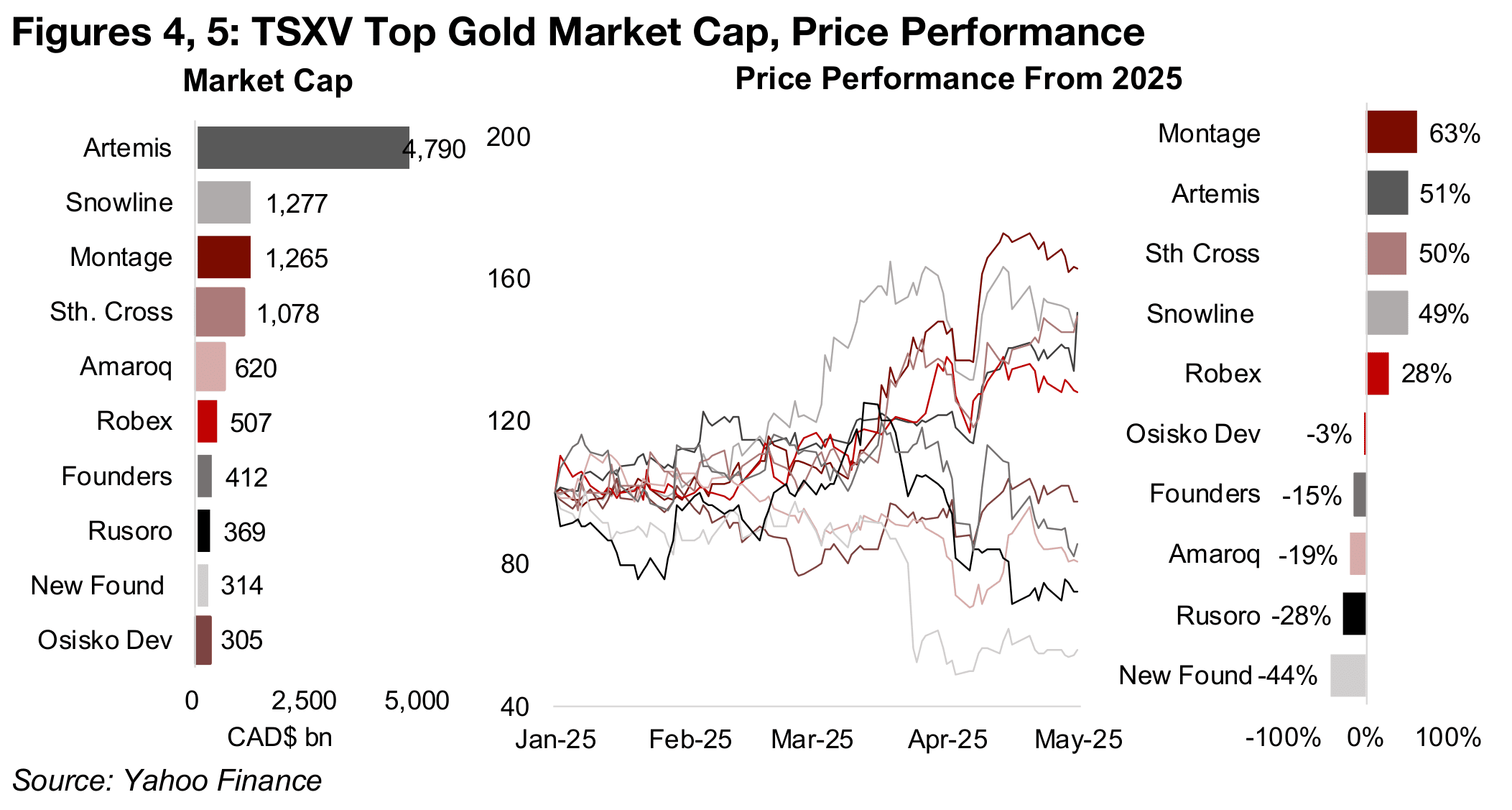
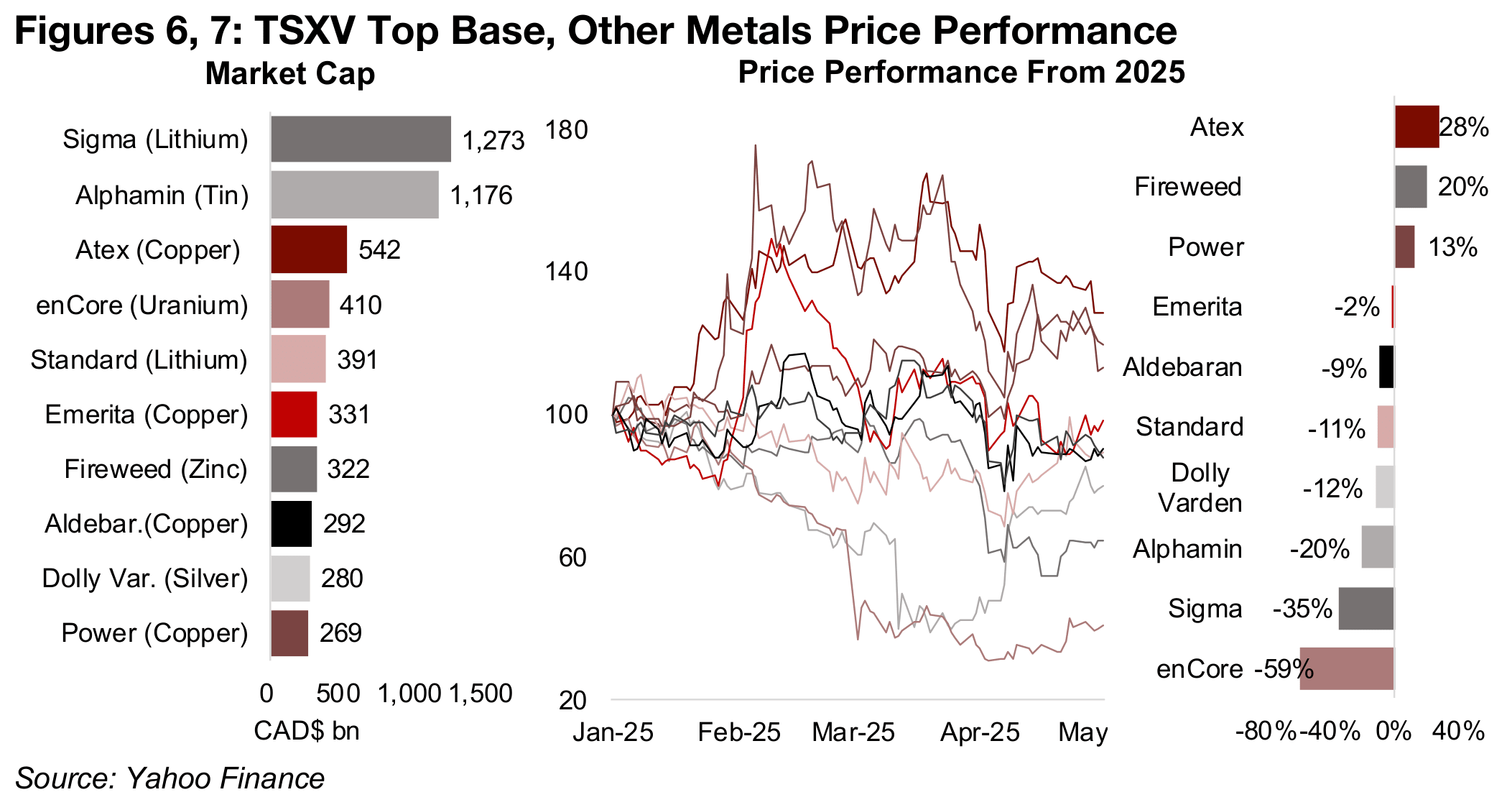
The largest rise for the base metals and other stocks has come from Atex Resources,
up 28%, on continued strong drill results from the Valeriano copper-gold project in
Chile, with a Mineral Resource Estimate released in 2023 (Figures 6, 7). The second
largest gains are from Fireweed Metals, up 20% as drill results remain strong from its
exploration-stage MacPass zinc project in the Yukon. Power Metallic Mines has risen
13%, on continued strong drill results from its polymetallic NISK project in Quebec,
with copper, nickel and PGE metals.
Emerita Resources has been near flat, down -2%, on strong drill results from its
Iberian West copper project in Spain, with an upgraded resource estimate released
in March 2025. Aldebaran is down -9%, with it announcing a delay last month in the
release of its PEA for the Altar copper-gold project in Argentina to Q3/25. Standard
Lithium has declined -11%, with its Southwest Arkansas project near production, but
the lithium price still under pressure. Dolly Varden has dropped -12%, as there have
been decent drill results from its Mineral Resource Stage Dolly Varden and
Homestake Ridge projects but only been muted gains in the silver price.
Alphamin has lost -20% on political issues with its Bisie tin mine in the Democratic
Republic of Congo. Insurgents in the area of the mine had driven an evacuation and
shutdown of production in March 2025, although operations were restarted in April
2025 after insurgents withdrew. Sigma Lithium has dropped -35% this year to a
market cap of US$1.3bn, down from around US$5.0bn at its peak in 2023, on the
plunge in the lithium price. The company currently produces lithium oxide
concentrate and construction that will double its capacity is ongoing. EnCore,
operating multiple uranium projects in the US, has plunged -59% on the drop in the
metal price, with its CAD$410mn market cap well below half of its peak last year.
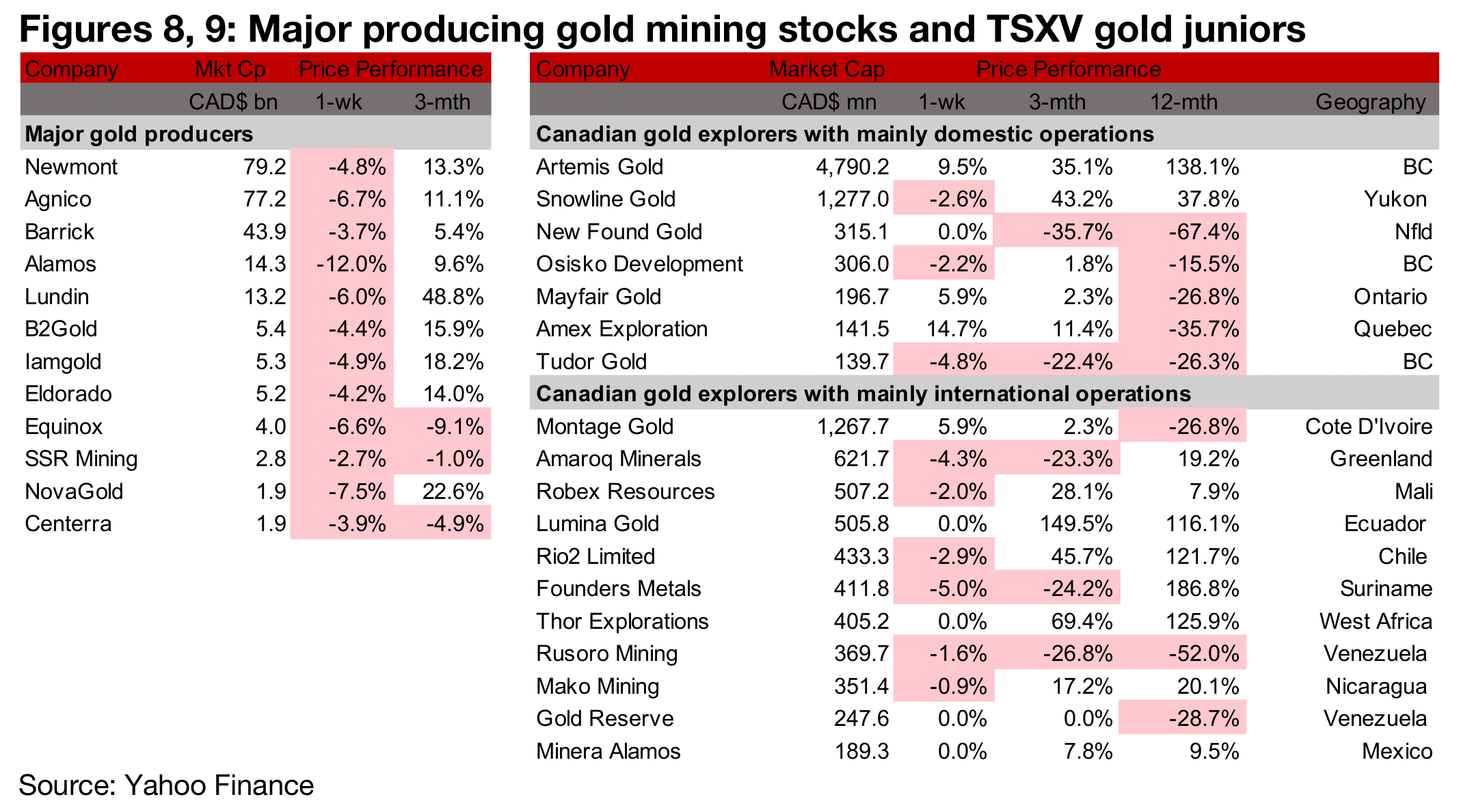
Major producers all slide while TSXV large gold mixed
The major producers all declined on the drop in the metal price and on a pullback after strong gain in recent months, while the large TSXV gold stocks were mixed (Figures 8, 9). For the TSXV gold companies operating mainly domestically, Artemis reported the start of commercial production, New Found Gold announced new drill results from Queensway, Osisko Development released a new Feasibility for Cariboo and Tudor Gold received an exploration permit for Treaty Creek (Figure 10). For the TSXV gold companies operating mainly internationally, Rio2 Limited provided an update on construction at Fenix, Rusoro Mining delayed reported its financial results and Minera Alamos gave an operational update on its three projects (Figure 11).
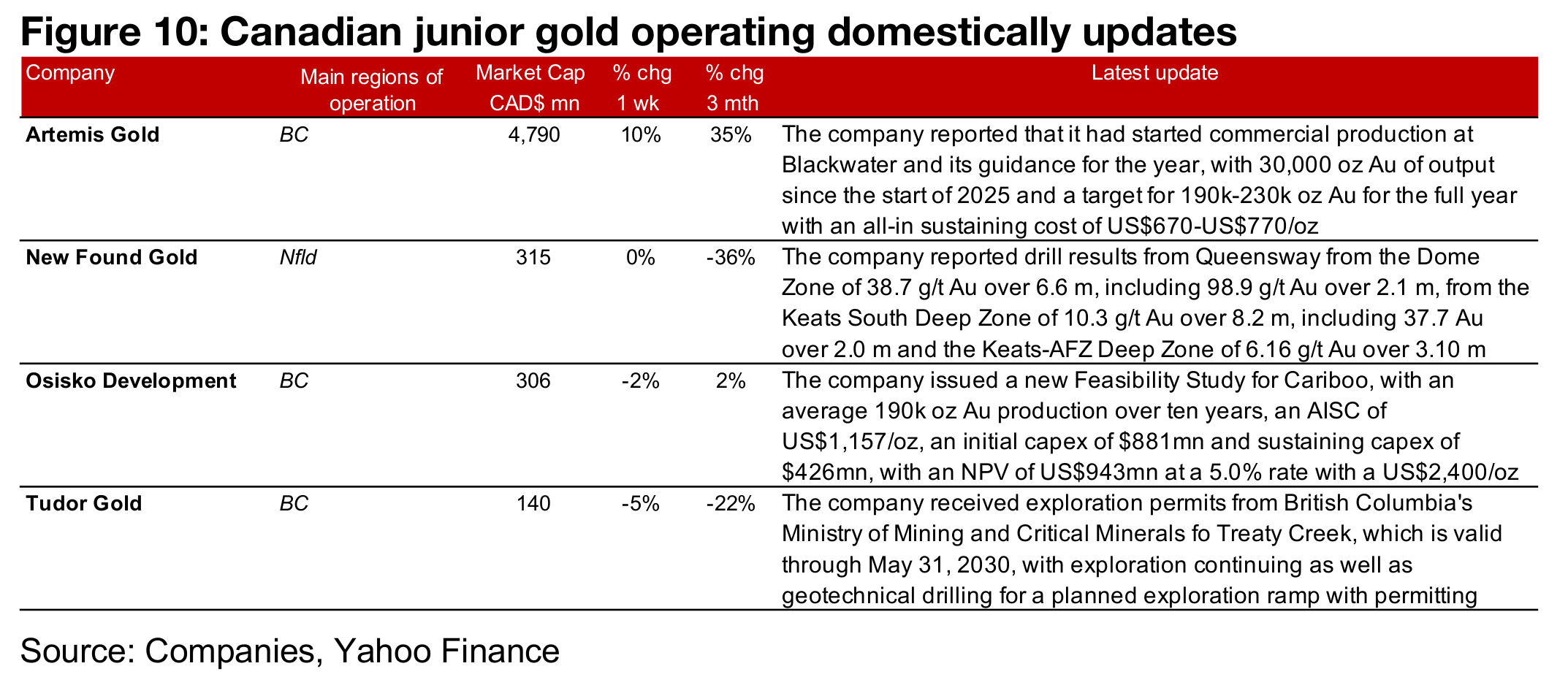

Updated Cariboo FS shows rise in NPV, initial capex, and gold price
The updated Cariboo Feasibility Study (FS) from Osisko Development included a considerable rise in the NPV for the project to CAD$943mn, up from CAD$502mn in the FS from December 2020 (Figure 12). Total payable gold for the project rose just 1% to 1,894, with the average output up 16% to 190k oz/year on a reduction in the years of operation from 12 to 10 years. One of the largest changes was an increase in the initial capex to CAD$881mn by over five times to just CAD$137mn. However, much of this was a shift of the expansion capex from the Dec 2022 FS to initial capex in the May 2025 FS. While the AISC also rose 20% to US$1,157/oz from US$968/oz these increase in costs were more than offset by the rise in the gold price assumption to an average US$2,400/oz. Given a current gold price that could be verging on US$1,000/oz above this estimate, it seems that this long-term average is achievable.

The PFS puts Cariboo toward the middle of the projects of the TSXV gold developers,
with its 1.9mn oz Au well below Lumina’s Cangrejos at 11.6mn and Montage’s Kone
at 3.57 mn oz, but above Rio’s Fenix at 1.3 mn oz, Amex’s Perron at 1.0mn oz and
Minera Alamos’ Copperstone at 0.3mn oz (Figure 13). However, CMOC has
announced recently that it would acquire Lumina, and Montage Gold will soon to list
the TSX. This will shift the Cariboo project to the largest of the TSXV development
stage gold projects in terms of resource size.
The grade of the project is reasonably high, at 3.40 g/t Au, with the grades for Lumina,
Montage and Rio2’s projects far lower at just 0.55 g/t Au, 0.72 g/t Au and 0.48 g/t Au.
Only Amex’s Perron has a higher grade, at 5.26 g/t Au, with Minera’s Copperstone
similar to Cariboo at 3.15 g/t Au. The Cariboo project stands out as reasonably high
cost, with a high initial capex given its size, at nearly the same level Lumina, which
has a six times larger resource, and high AISC at 1,157/oz. The post-tax NPV for
Cariboo is US$764mn, although this is not wholly comparable with the other projects.
This is because the Cariboo Feasibility Study is the newest of the group and includes
a far higher gold price assumption that the other projects at US$2,400/oz.
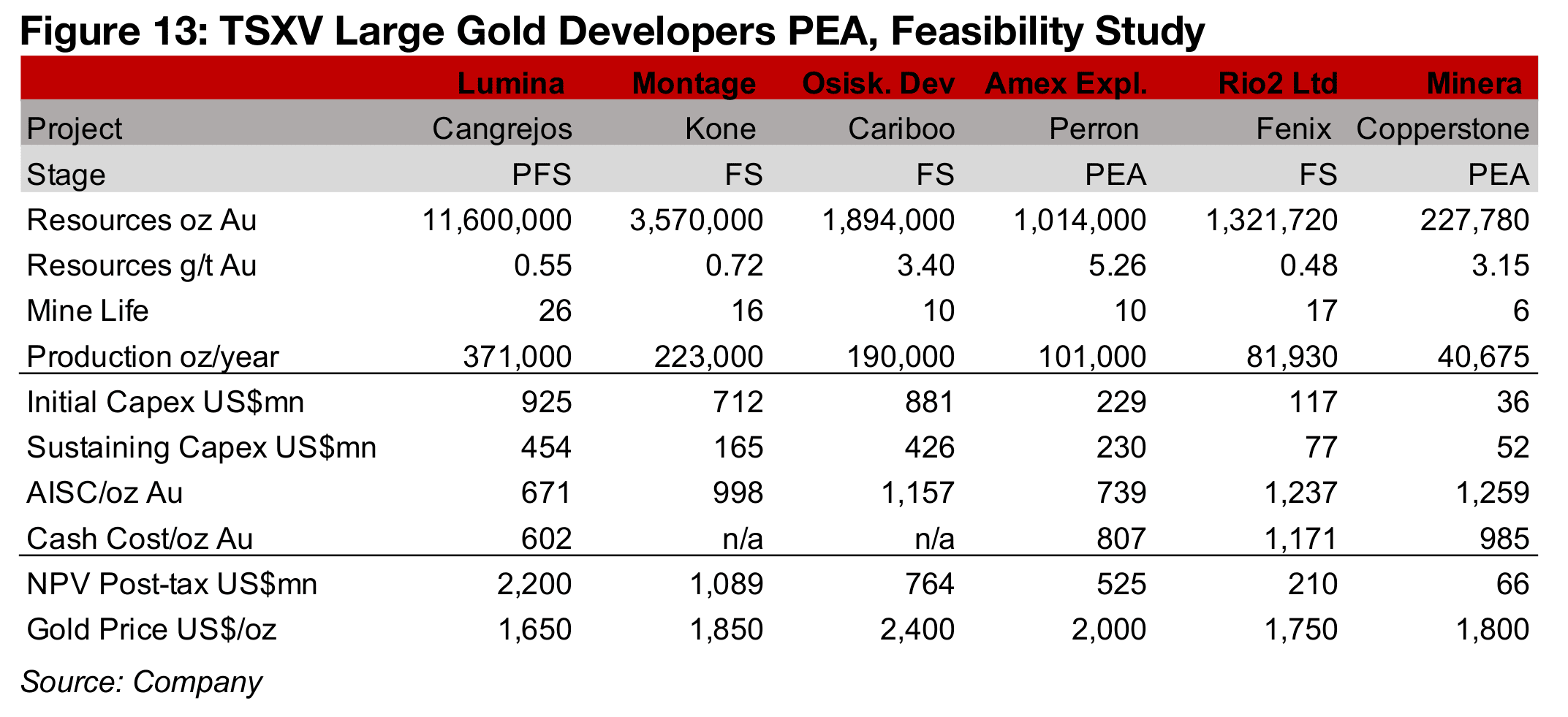
Disclaimer: This report is for informational use only and should not be used an alternative to the financial and legal advice of a qualified professional in business planning and investment. We do not represent that forecasts in this report will lead to a specific outcome or result, and are not liable in the event of any business action taken in whole or in part as a result of the contents of this report.


